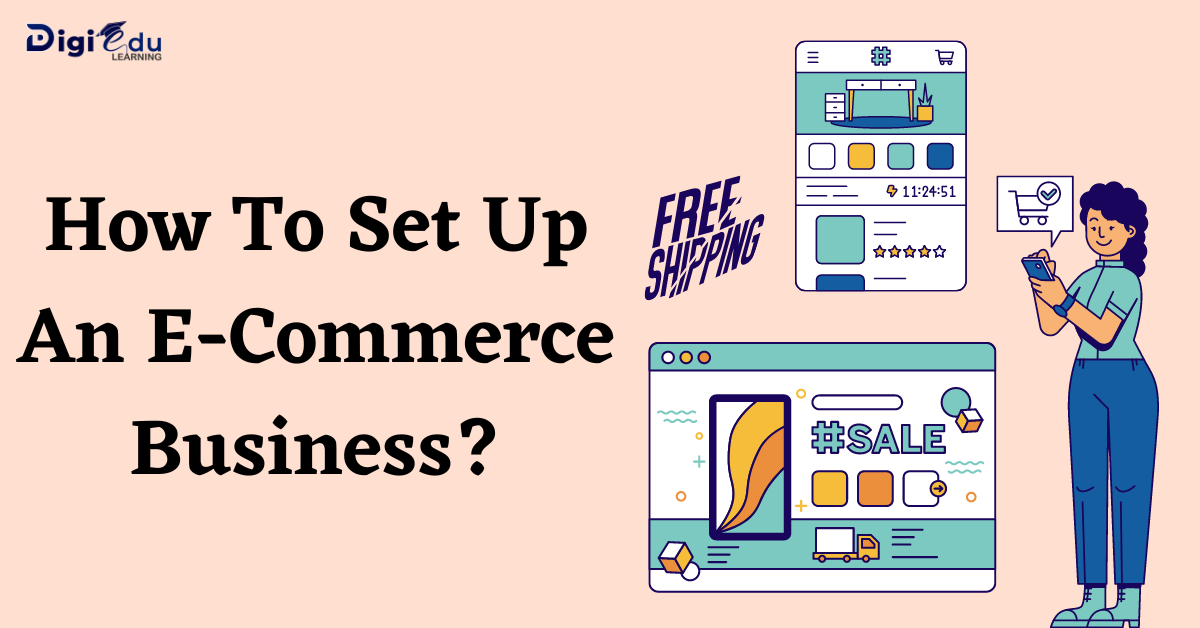If you’ve ever dreamed of starting an e-commerce business, congratulations on your decision. The world of online shopping is huge and there are many opportunities for success. However, the road to building a successful e-commerce operation isn’t easy—and it takes careful planning and preparation to get off on the right foot. Here are some tips for getting started with an e-commerce store:
#1 Choose A Business Model.
When it comes to choosing a business model, you have several options. The most common types of eCommerce businesses are:
Shopify stores are the most popular type because they’re easy to set up and use. They also offer some great tools for growing your store, but they don’t provide as much profit potential as other models do.
WordPress websites (also known as “websites with plugins”) can be even more customizable than Shopify sites but may require additional technical skills on your part if you want everything to work smoothly for visitors who come from outside your site (eBay).
#2 Pick A Niche And Decide What To Sell.
- Determine your niche.
- Know your target audience.
- Know your competition, and research their offerings to see what they are selling, who they are selling it to, and how much they charge for it.
- Figure out what you can do differently than the competition that will make it worth buying from you (and keep in mind that this may not be the case). If there’s something similar on the market already but does not have enough demand yet (like an animal rescue organization trying to sell its services), consider making a different product or service entirely—for example: instead of running a pet-sitting website where people can drop off their dogs while they travel around town during business meetings or take care of them during long flights home from work every night; maybe start offering daycare services so owners can leave their pets at home without worrying about leaving them alone all day long!
#3 Perform Market Research And Validate Your Product.
Market research is a process of collecting information about the target market and the competition. This can be done through surveys, focus groups, interviews with customers, and more.
The first step in doing market research is determining what type of product you want to sell; this will help narrow down your options as you seek out buyers. It’s also important to identify any current problems or trends within your industry that may affect your business model (or vice versa). You should then decide how much money you’re willing to spend on each piece of market data—the less expensive it is, the better; otherwise there’s no point in pursuing it at all!
#4 Register Your Business Name And Get A Business License.
Registering your business name is the first step in setting up your e-commerce business. It’s important to register a legal name with the state and federal government because you’ll need it for tax purposes, as well as to open bank accounts.
The business license is not required for all businesses, but some states require one before their residents can sell goods online or use other online services like postcards or packages delivered via mail service companies like FedEx or UPS. The majority of states don’t require a business license if they’re only selling products that have been shipped from within that state—for example, if you sell products made in another country but ship them directly from within its borders (as opposed to having them shipped through an international shipping company).
#5 Get A Sales Tax Permit Unless You’re In One Of The Few States That Do Not Require One.
If you sell products in the United States, you will need to charge sales tax. If a customer does not pay it, they may have their purchase returned to them and face legal consequences for non-payment.
The easiest way to ensure that your business is operating legally is by getting a sales tax permit from your state’s department of revenue (or equivalent). Some states only require one permit; others require more than one permit depending on whether or not they have an online presence or if they provide services through other means besides digital storefronts like mobile apps or web applications.
#6 Consider An E-commerce Platform.
When you’re starting out, it’s all about the basics.
You need a website and an email address that people can send you messages. You also want to be able to accept credit cards as well as PayPal payments.
But once you’ve got those things down, how do you grow your business? The best way is with an e-commerce platform like Shopify or BigCommerce that provides all of these tools plus more:
An easy-to-use interface so customers won’t have any trouble finding what they’re looking for on your site;
Good customer service which allows them to get in touch with someone quickly if there’s ever an issue;
The right tools for running your business efficiently (like inventory management software)
#7 Get On The Right Side Of SEO.
SEO (Search Engine Optimization) is a long-term strategy that can take months or even years to achieve. It’s not just about keywords and keyword research, but also about creating content that your customers want to read, building links back to your site, and making sure you’re using the right analytics.
If you want to get more traffic from Google searches, then it’s essential that search engines are able to find relevant information about what people are looking for when someone searches for it. This means having great content on your website so that when someone does a search for “eCommerce” or “online shopping” they will see something relevant on their results page – something which reflects both their interests and those of other users who have searched before them.
#8 Secure A Domain Name And Web Hosting.
Your domain name and web hosting are two of the most important pieces of your e-commerce business. To get started, you need to choose a domain name that is easy to remember and spell, as well as one that’s available.
Choosing a domain name can be tricky because there are so many options out there! Domain names are often chosen by people who have an idea of what they want their site to be about or how it will look like when finished up (for example: “my awesome blog”). You might also want something short and simple like “e-commerce” if this is your first time setting up an e-commerce website; however, long-tail phrases have been proven more successful because they tend not only to attract visitors but also encourage them through word-of-mouth marketing from other users who use similar words on their websites/blogs/social media accounts (i.e., Etsy).
Web hosting refers specifically to where files used in creating websites reside on servers located somewhere outside our physical location; thusly making sure these files remain secure even if someone tries hacking into them at some point down the road since most providers offer 24/7 support services should anything go wrong during setup or maintenance periods.”
#9 Start Building Your Store.
Once you have your product, it’s time to get started. Building an e-commerce store is much like building any other business—you need to plan, organize and strategize before you can start making money.
The first thing that needs to be done is to create a good design for your website. This is important because it will help people find what they are looking for when they visit the site, but also because it will show off all of the great work and effort that went into designing this site so that customers know how much thought was put into creating their experience here at [your company name].
There are many different things that should go into designing an effective eCommerce site: from having good search functions (which allow users easily find products), upselling tools (such as coupons) or discounts based on past purchases, etc. It also helps if there’s some sort of reward system going on where customers who spend more money get rewarded with points or credits towards future purchases which could then be used towards freebies offered by certain manufacturers/retailers such as Amazon Prime memberships etc.
#10 Set Up Payment Processing And Accounting Procedures.
Having a payment processor is crucial to your success. You can’t just expect customers to pay you without them knowing how and where the money will be going.
You’ll also need accounting software like QuickBooks or Xero if you want to keep track of your finances, so make sure this is set up before launching your business!
#11 Set Up Shipping For Physical Products Or Digital Download Links For Digital Foods.
Now that you have your e-commerce site set up, it’s time to get shipping right. Shipping is an essential part of any business and can be difficult to implement correctly.
If your product is physical and requires shipping by a carrier (such as UPS or FedEx), here are some tips for setting up shipping:
Make sure everyone working with the orders understands what will happen if there are no tracking numbers provided by the customer. If they do not know this and ship without them, then there will be no way for them to track their packages once they leave the warehouse/shipping center. This may cause delays in receiving shipments from customers who paid extra money for faster delivery times – which would be bad news! So make sure everyone knows about this before sending out any products at all! * Use stickers on boxes when sending large amounts (or any) amount of products–this makes it easier for customers who receive damaged goods due to improper packaging techniques or mishandling during transport.*
#12 Define Your Customer Service Policies And Create Product Return Procedures, If Applicable.
Customer service policies and procedures can help you stand out from the crowd. They’re an important part of your customer experience, which is why it’s crucial to have them in place before you start selling online.
Customer service policies will help you retain customers, as well as grow your business by helping you understand what customers want from their experience with you (and what they don’t). If a customer has a complaint or issue with one of your products or services, having information about how to handle that situation will be helpful when dealing with them directly.
#13 eCommerce Businesses Have High Competition, But With The Right Planning, You Can Stand Out From The Crowd
E-commerce businesses have high competition, but with the right planning, you can stand out from the crowd.
Have a unique selling proposition (USP). This is your unique way of doing things that sets you apart from other companies in your industry. It’s not necessarily about how much money you make or how many sales you make; it’s about helping people solve their problems in a specific way and providing them with something they won’t get anywhere else.
Market your business effectively. You need to market yourself properly so that potential customers know what to expect when they visit your store or website and which products are best suited for their needs—and remember: everything has its price on Amazon!
Have an excellent website – this is where all of this information comes together into one place so anyone who wants more information can find it easily without having too much trouble navigating through pages filled with text only meant for SEO purposes (which means less time spent reading!)
Conclusion
We hope this article has been helpful in getting your e-commerce business off the ground. For more information, check out our website www.digiedulearning.com






